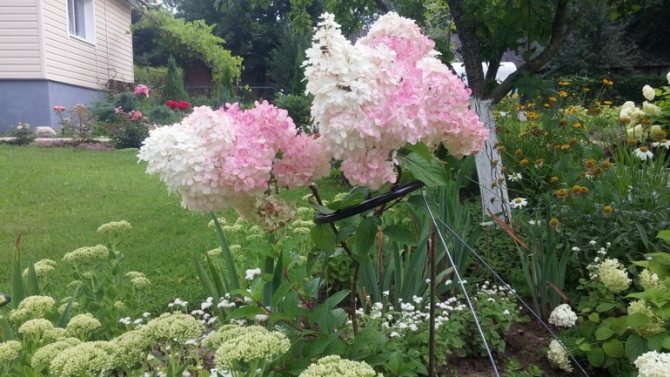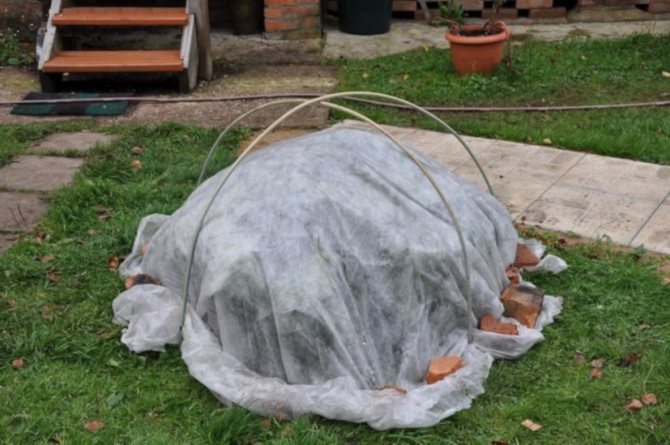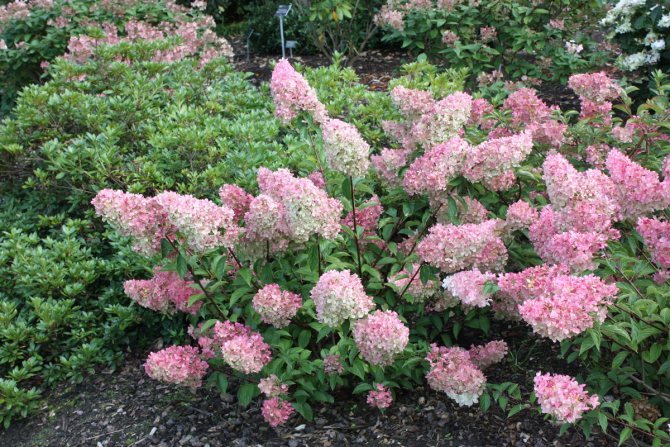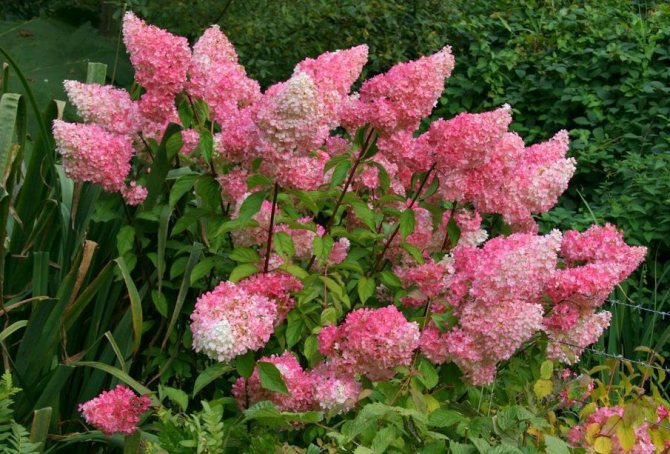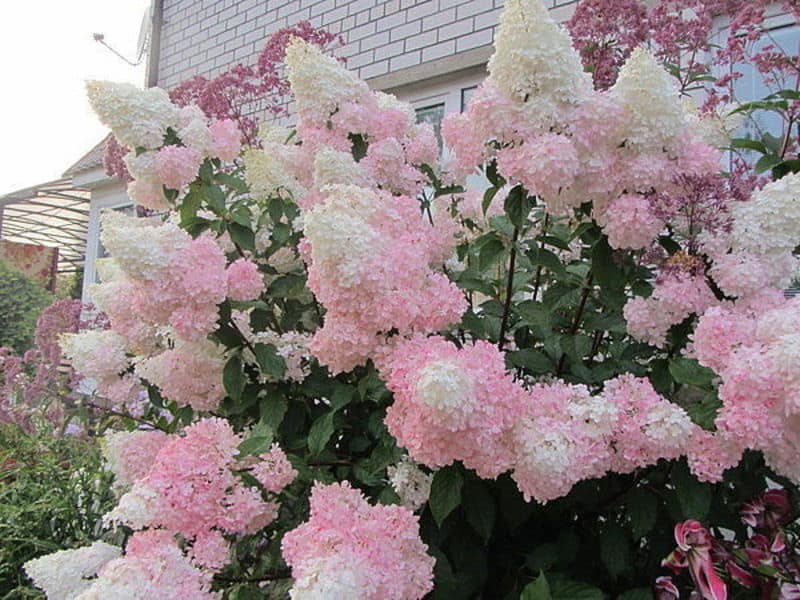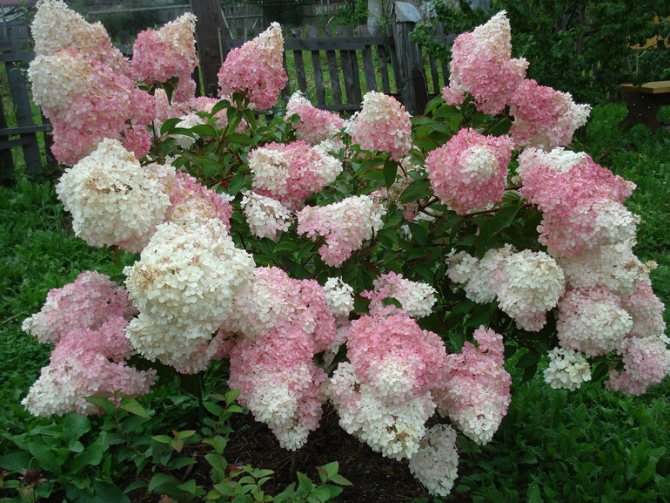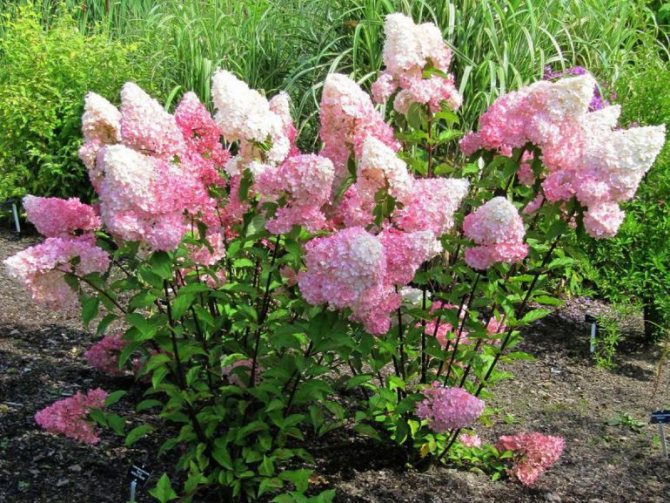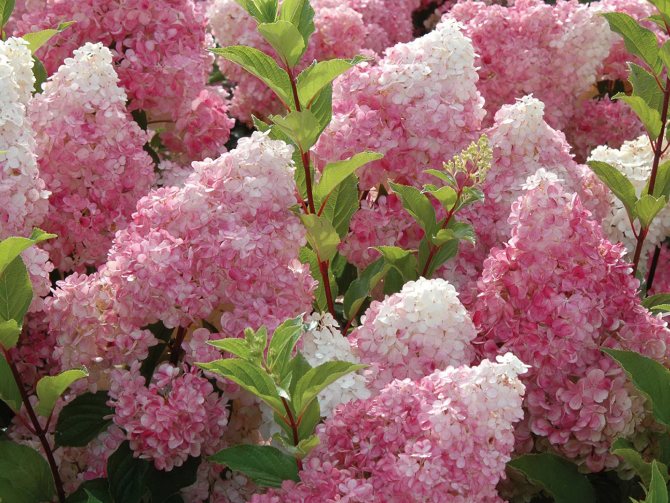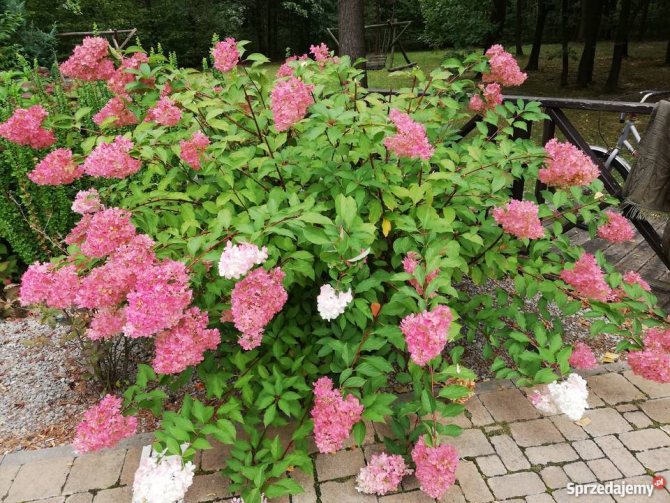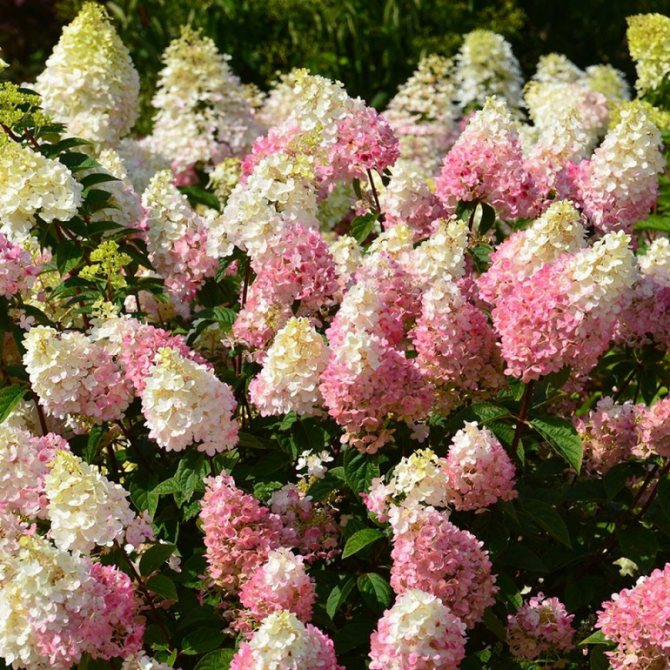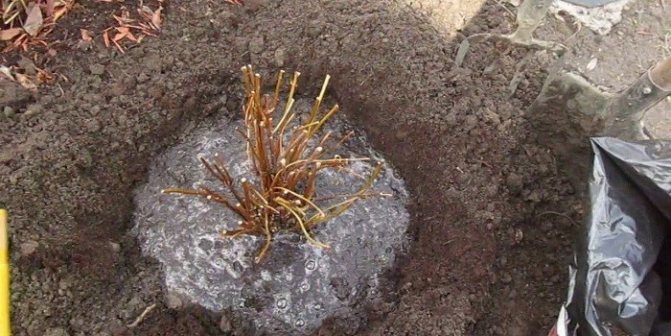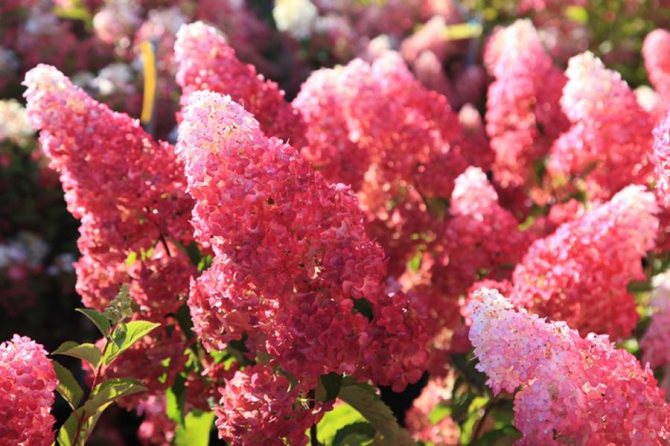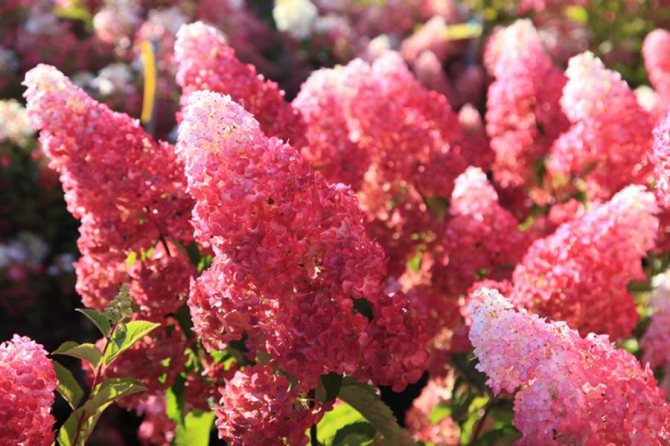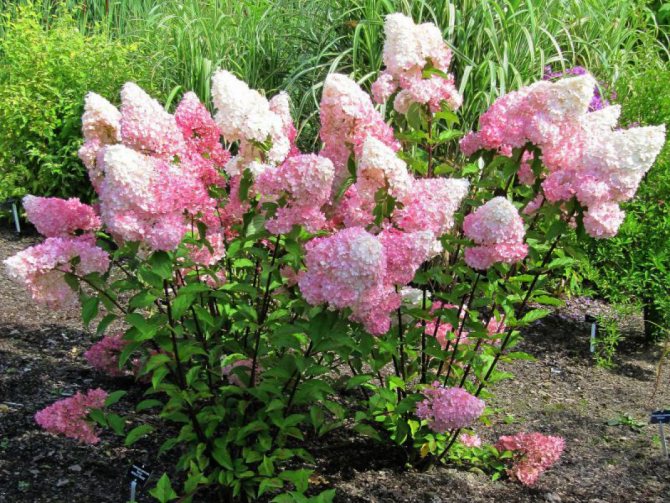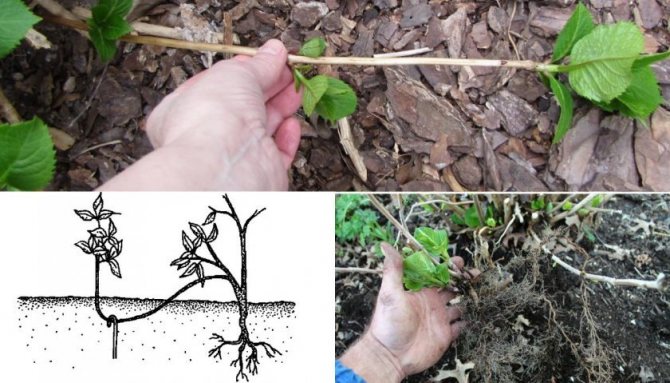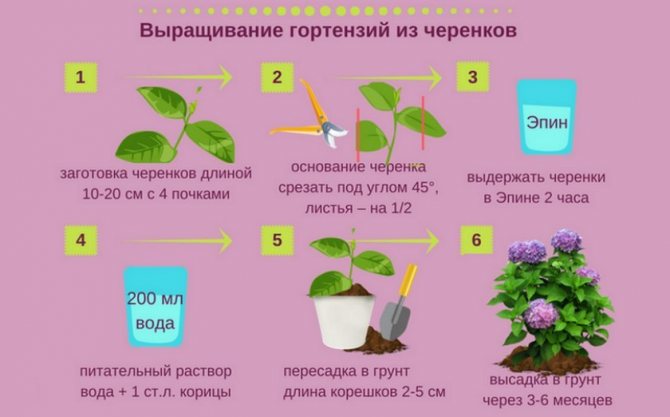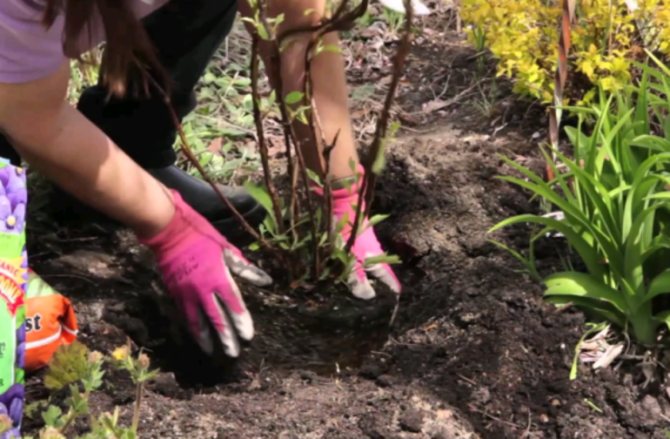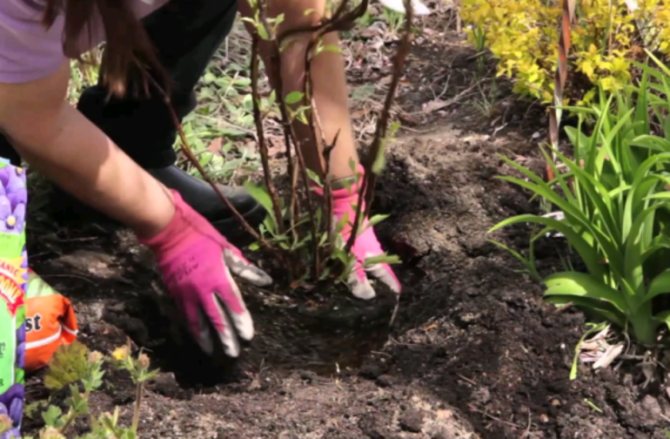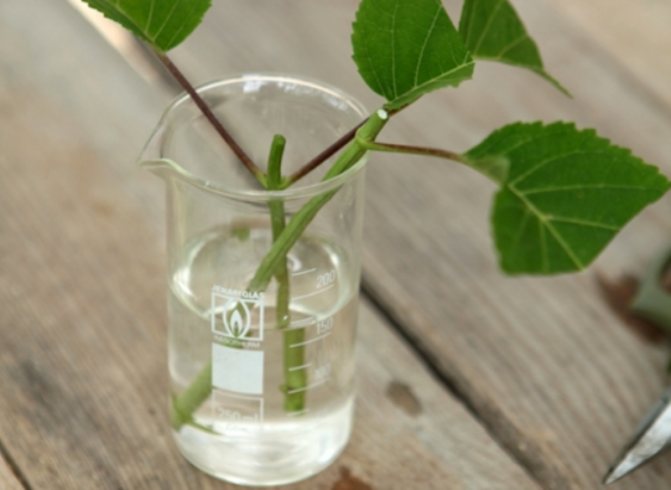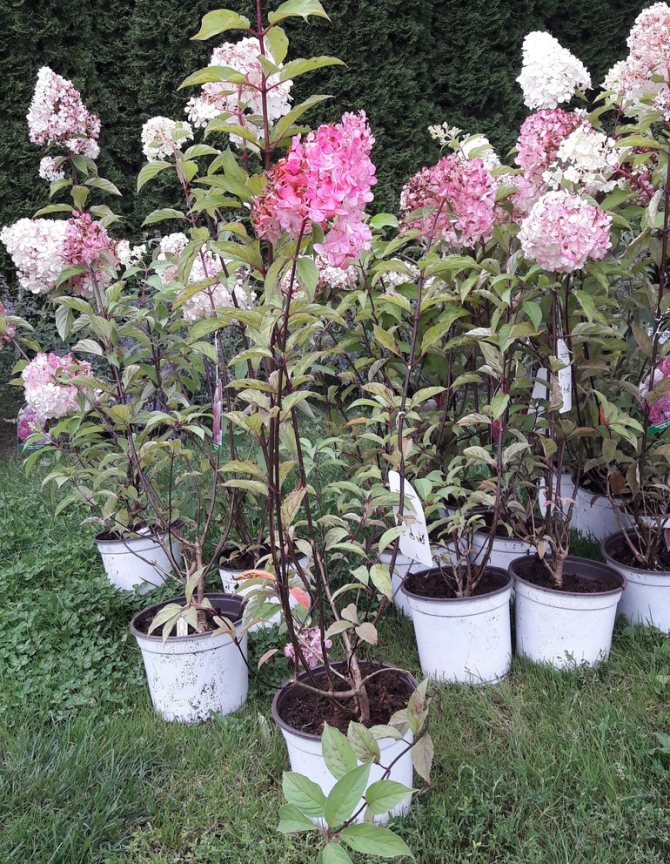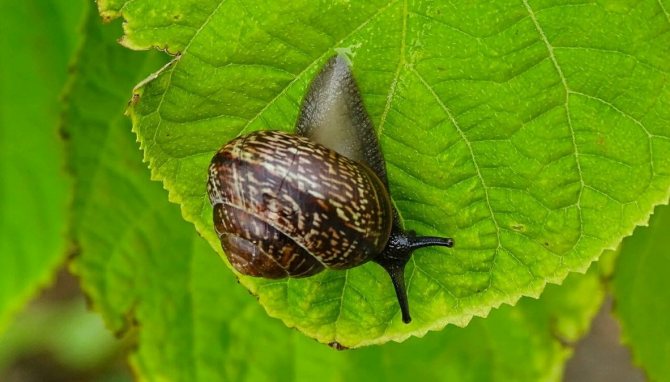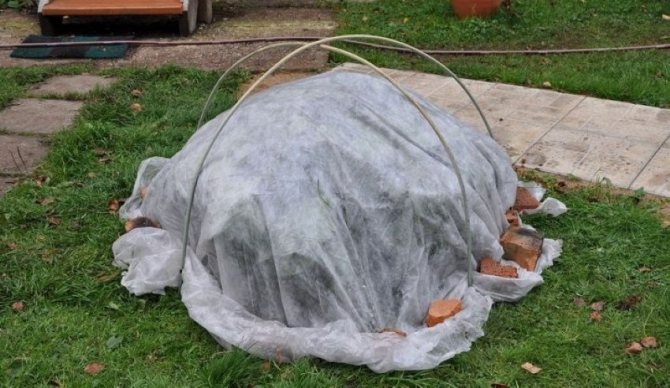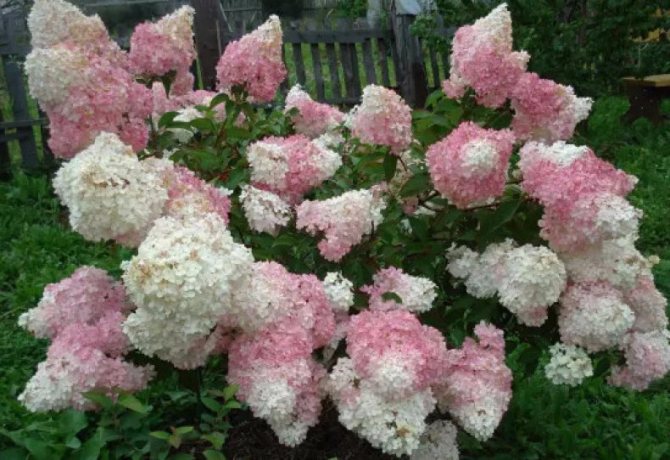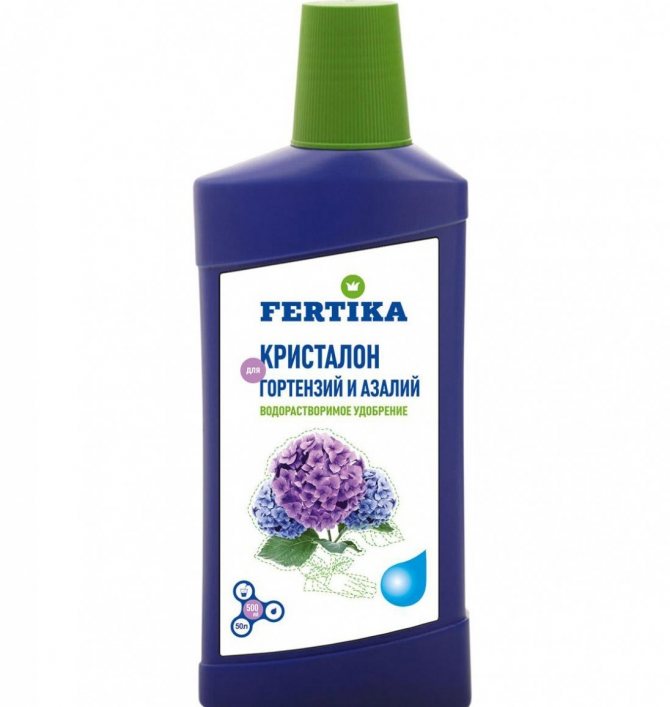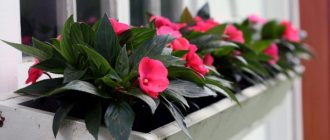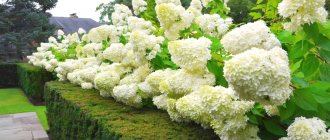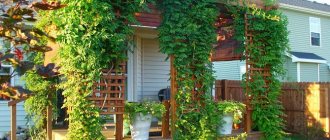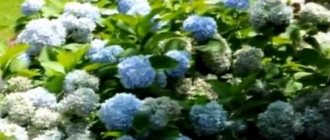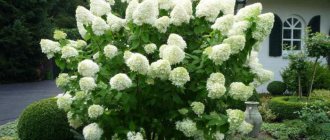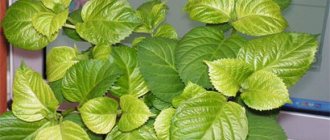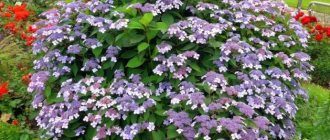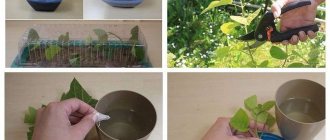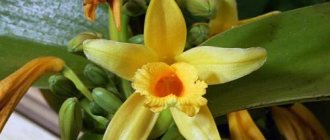Home - Florist's corner - Panicle hydrangea "Vanilla fries" - the most beautiful and unpretentious garden shrub
There are quite a few varieties of hydrangeas - tree-like, paniculate, large-leaved, oak-leaved, petiolate, serrate. My hobby is panicle hydrangeas. One of my favorite varieties is Vanilla Fraise (Hydrangea paniculata Vanille Fraise).
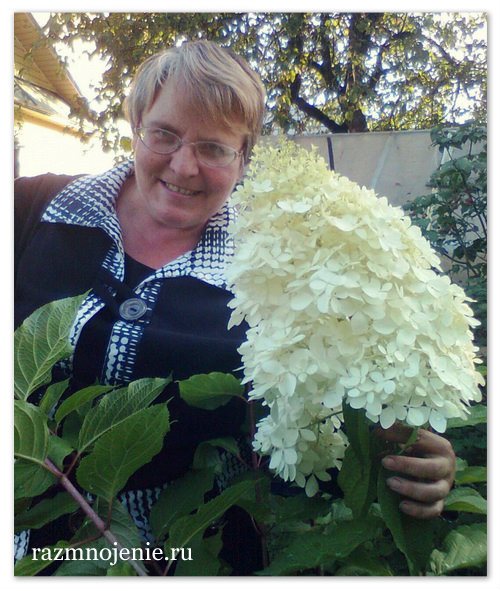
I saw a photo of her in a magazine and was simply fascinated by her. It was difficult to buy this variety in free sale in Russia at that time. But I searched hard, phoned friends, looked through advertisements in magazines. If you really want something, you will definitely get it. Soon I met a family of Muscovites who are engaged in just the cultivation of hydrangeas. It was they who gave me three cuttings of the desired variety.
Characteristic features of the variety "Vanilla Fries"
Having decided to acquire this variety of hydrangea, you should remember the size of the shrub. It grows up to two meters in height in a fairly short period of time, and blooms in July. Vanille Fraise's inflorescences are large, reaching 30 cm in diameter, incorporeal and pyramidal, last all summer until mid-autumn.
The variety has an unusual color. On the same bush, both white and bright red flowers can coexist. The pink border does not appear at the edge of the inflorescences immediately. At first, the panicle hydrangea is covered with exclusively white flowers, which gradually turn pale pink, and then deeply crimson. This unusual feature of the change in petals allows you to observe several different shades on one bush at once.
Hydrangea Vanilla Fries is popular in the design of backyard and adjoining territories, small and spacious gardens, squares and parks, hedges. The shrub also looks great as a separately growing planting. In order for Vanille Fraise to smell and develop, this hydrangea variety needs not only to provide proper care, but also to choose the right planting site.
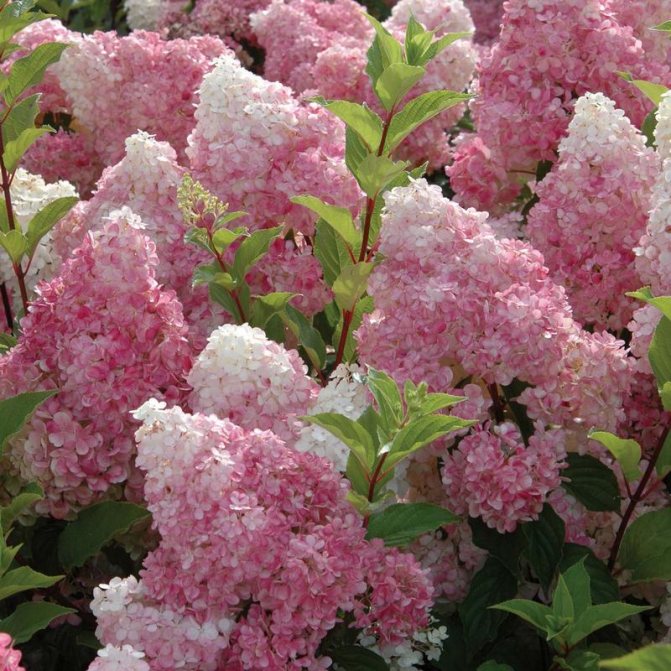

Hydrangea Vanilla Fraz, planting - when and how to plant
When to plant panicle hydrangea? The best time for planting is spring, but it is also possible in the fall, a month or more before the onset of frost, so that the hydrangea has time to take root. Depending on the growing region, in the northern regions, including the Urals and Siberia, experienced gardeners still recommend leaving the planting until spring days, since the risk of sudden frosts is very high. The root system will not take root properly, if the frost "crushes" and the plant is likely to die. In the southern regions (in the Krasnodar Territory, Stavropol Territory, the Republic of Adygea and others), planting the Vanilla Freise hydrangea is possible in the fall, until November, if the weather is good.
Hydrangea paniculata Vanilla Freise - planting and care in the open field for which, not too difficult, still requires attention and the correct approach to cultivation. The planting time of hydrangeas in different regions is different, in the spring - the main thing is that the snow melts and the ground freezes to a sufficient depth, then you can plant seedlings.
When choosing a place for planting hydrangeas, you should pay attention to the fact that in the sun the inflorescences are brighter and larger, in the shade they may not grow large. But, in the southern regions, it is better to provide a place in such a way that there is partial shade, since the inflorescences can fade and dry out in the bright sun. In the middle lane and in the north, it can be planted in open sunny areas.
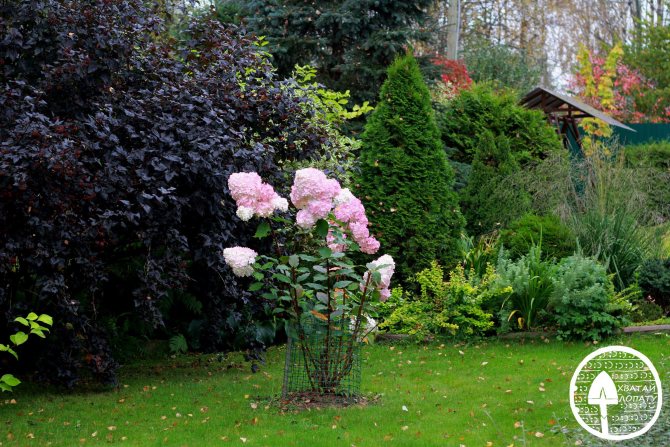

planting hydrangea Vanilla Fraze
Vanilla Freise - planting is carried out in small pits, measuring 0.4x0.4 m, the composition of the soil mixture is as follows:
- take 2 parts of humus
- the same amount of leaf land
- one part of peat chips and river coarse sand.
If it is not possible to prepare the soil on your own, purchase it in the store, the main condition is that the soil mixture for planting must be well-drained. Pour the soil mixture into the hole with a mound, straighten the roots and fill in, compacting the seedling well. The root collar is not buried during planting. From above, it is recommended to mulch the surface with peat or pine bark, which, in most cases, overheat during the summer season, thereby the acidity of the soil will be at the proper level. Remember to water well the young hydrangea seedling.
How to plant Vanilla Fries correctly?
Gardeners who decide to plant a frost-resistant hydrangea variety must clearly follow a certain sequence of work that allows them to grow beautiful and vigorous shrubs with large flowers that adorn the landscape for four to five months on the garden plot. They consist in the following stages:
- choosing a place for planting and seedlings;
- preparing the right soil;
- preparation of seats;
- planting seedlings.
Each step is of paramount importance, since adherence to the conditions for proper planting determines how well the panicle hydrangea will take root, develop and bloom. Therefore, it is simply necessary to follow all the recommendations if an ornamental shrub is planted for the first time. It is best to plant a hydrangea in the spring, and start preparatory work in the fall.
Pruning
In order for the panicle hydrangea to bloom in large inflorescences, pruning of the shoots is necessary.
Until the age of four, I do not touch the bush, let it grow. I always prune hydrangeas over four years old. In the fall, I remove the faded inflorescences, shorten the young growth, leaving 4 buds each. In the spring, I cut out frozen, old, weak and growing shoots inside the bush. You should not often cut paniculate hydrangeas too much, as they can form many shoots and, as a result, thicken strongly.
Seating and material
The plant thrives best in a well-consecrated space. Light partial shade does not have any negative impact. Shaded areas that are not exposed to sunlight should be avoided. A shrub under these conditions will grow stunted and less attractive than a hydrangea that receives enough natural light.
Young seedlings are rather fragile. They can break in strong winds. The best option would be to choose a site with fruit trees growing on the leeward side or a high hedge. This will protect the shoots from damage. Otherwise, seedlings that cannot withstand the load will be damaged and most likely will not grow into a full-fledged shrub.
Planting material must be taken exceptionally healthy. Choosing it either in the store or from one of the gardeners you know, you should carefully consider the escape for the absence of mechanical damage and insects.
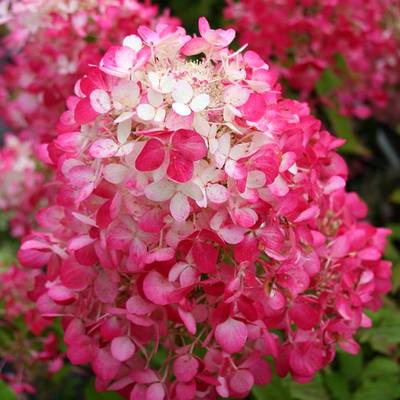

Reproduction of hydrangea
If you have a Vanilla Freise hydrangea bush, you can get seedlings yourself. To do this, in the spring, several shoots with buds are cut off and immersed in a solution of the Kornerost stimulant. Then the cuttings are planted in the garden.
The plant is watered, fed with organic matter, protected from the hot sun. After rooting, the hydrangea is planted over the site.
Advice! When transplanting hydrangea Vanilla Freise, you can divide its rhizome into parts and get planting material.
Another effective way to propagate shrubs is to use layering. In the spring, the lower parts of the shoots are cleaned of leaves and fixed to the ground. Fertile soil is poured on top. By autumn, the plants will take root, and you can separate them from the bush.
The soil
The qualitative composition of the soil must be taken care of in advance. If for some reason the soil is not made in the fall, then you can do this before planting seedlings. However, given that the land requires some changes in the composition, it must be done in at least two, and preferably three weeks. Hydrangeas love acidic soil and Vanilla Fries is no exception. Organic and mineral fertilizers are applied to the ground. Equal amounts of turf, river sand, humus, peat, leafy earth are mixed together. Immediately before planting, the soil is acidified using means like "Acid plus".
I plant young bushes in the garden
When the roots of the young plants had well wrapped a clod of earth in the pots, I planted them in the garden. For the "Vanilla Fries" variety, you need to choose a place so that in the morning and after lunch the bush is well lit, and a shadow falls on it during the day.
Planting soil prepared from a mixture of peat, sand, garden soil, old humus. To acidify the soil, I added a bag (30 g) of colloidal sulfur to it. Instead of sulfur, you can take potassium sulfate (200 g per one planting pit with a diameter of 50 cm).
It is necessary to plant a rooted stalk no deeper than it sits in a pot. After planting, spill well with water.
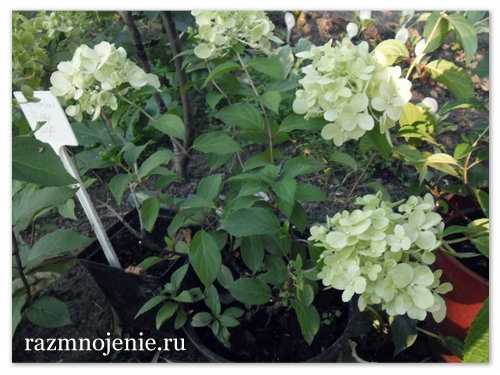

Preparation of seats
The next step after soil preparation is to perform the following steps:
- in a predetermined area, they dig out recesses at least 50x50 cm (width and depth), and when planting several bushes between the pits, keep a distance of about half a meter;
- the bottom of the pit is laid with a drainage layer equal to about 10 cm, using small pebbles, river sand, broken brick;
- fill the dug holes with a substrate prepared for hydrangea, creating an ideal environment for growing a plant.
Prepared seats are necessarily given some time to “be at ease”.
Varietal characteristics
The Vanilla Freise variety was bred in France. Development began at the end of the 20th century. The main goal of breeders is to create an unusual variety that will change the color of the buds. The planting material of the Melba variety was taken as a basis, from which Vanilla received high indicators of frost resistance, therefore planting in the northern regions of the country is possible.
In 2003, 30 years after the creation of the culture, it was included in the State Register of the country.
Flowering culture
Among all the flowers grown in the flowerbed, the panicle hydrangea has an unusual flowering. The culture has pyramidal inflorescences. Each bud is 40 cm wide and up to 30 cm long. The appearance of the buds is similar to vanilla ice cream with strawberry filling.
Long flowering. The first inflorescences appear in mid-June and stay on the bushes until the end of September. If weather conditions permit, then flowering continues until October. The optimum temperature for prolonging the life of flowers should not be lower than 15 ° C.
The main feature of the panicle hydrangea variety Vanilla Fries is the color of the buds. From the first days of flowering, they have a white tint. Over time, around the end of July, a pink bloom appears along the edges of the petals. At the beginning of September, the lower part of the bud changes, which acquires a bright pink color.
The appearance of the bush
Based on the description, the size of the bush reaches a height of 2 m. Shoots of a rich brown shade, flexible. Oval leaves are evenly distributed throughout the structure of the bush.
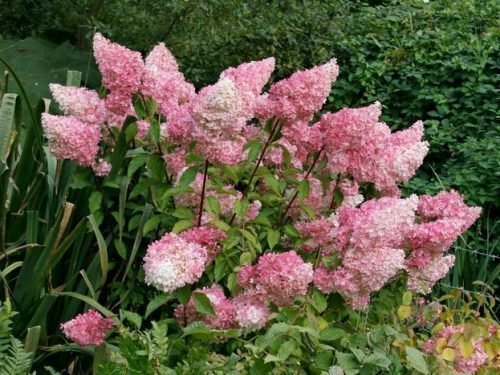

The shade of the foliage is dark green. It has small white stripes on it. The root system reaches a depth of 40 cm. Buds are gray-brown in color.
Watering
Both young seedlings and adult Vanille Fraise hydrangeas need abundant watering. If in the spring months there was practically no water or the summer turned out to be dry, the bush is watered abundantly. Excessive moisture is dangerous for the plant.It can lead to fungal diseases and the formation of rot, so watering should be moderate in rainy springs and cool summers. Do not water the shrub with tap water. If possible, it is recommended to use rainwater. An ordinary one is also suitable, but only settled and always warm.
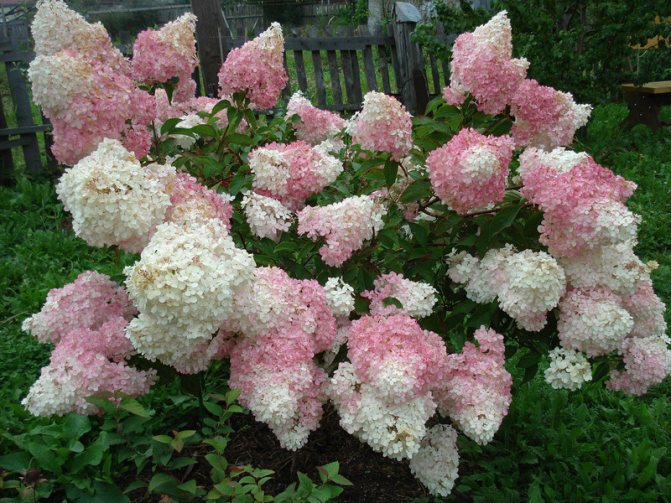

Gardeners reviews
Daria, 24 years old, Moscow region
For planting in the country, I bought a hydrangea Vanilla Fraz. The shrub produces many pyramid-shaped inflorescences. The variety attracts with its unusual color scheme. The color scheme of the inflorescences changes from white to burgundy. Our bush is 2 years old, its height reaches 50 cm. 7-8 inflorescences bloom on it. Hydrangea endures the winter without shelter. I water the bush every week, in a drought - every other day. I additionally feed with potassium nitrate.
Tamara, 38 years old, Lipetsk
A neighbor advised me to grow a hydrangea a couple of years ago. The cattery liked the variety Vanilla Freyz very much. I dropped him off in a sunny place under the window. The shrub blooms for 2-3 months. The petals initially have a greenish tint, which changes to white and pink. The color saturation depends on the acidity of the soil. The plant is not afraid of spring frosts.
Natalia, 53 years old, Saratov
Hydrangea is one of the most beautiful shrubs on my site. Particularly pleasing with the beauty of flowering and unpretentiousness is the Vanilla Freise variety. For planting, I dug a hole, where I covered the forest soil from under the pine. Fertile soil was poured on top. With this method of planting, acidifiers can be dispensed with.
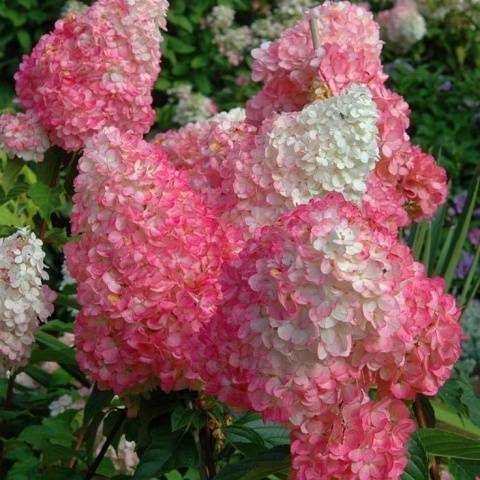

Fertilization
The first feeding is carried out in the second year after planting the seedlings. In the first season, young shoots receive all the necessary substances from the harvested substrate. The first time fertilization is applied before the beginning of the growing season, that is, in the first or second week of April, and the second fertilization is carried out during the formation of buds, and then twice a month throughout the summer.
Hydrangeas need mineral components. It is recommended to use superphosphate, potassium nitrate and ammonium nitrate. These fertilizers help to prolong the color period. They also help the shrub grow abundant green foliage. Without the timely introduction of top dressing, the hydrangea will not fully reveal its decorative effect.
How I take care of my darling
Hydrangea care is not difficult. In the spring I feed it with any nitrogen fertilizer (usually nitrate or potassium nitrate), in the summer - with fermented grass or a special fertilizer for hydrangeas (you can take fertilizer for azaleas and rhododendrons). Closer to autumn I add superphosphate.
Do not apply under hydrangeas (any) ash, dolomite flour or lime, they alkalize the soil, and these shrubs require increased soil acidity. Top dressing is needed for lush flowering in the summer and the laying of new flower buds in the fall.
Hydrangeas love to drink (hydrangea from the word "water"). So that the earth does not dry out, I mulch the surface around the bushes with peat or well-rotted sawdust with a layer of 8-10 cm.
So that my hydrangeas develop well and bloom, every month in the summer I spill the soil under them with acidified water. I add 1 teaspoon with a heap of citric acid or 100 ml of 9% vinegar to a ten-liter bucket of water. This should be done regularly.
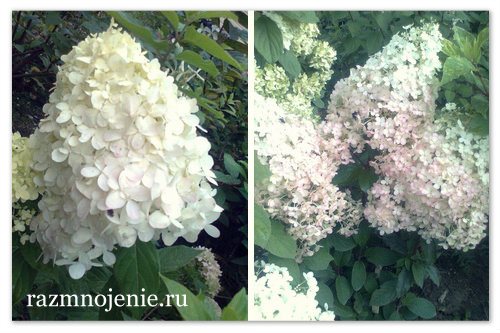

Mulching and loosening the earth
Young shoots of the first year of life need mulching. Surface covering of the soil with mulch must be carried out for adult specimens. It helps to retain moisture in the substrate and is an additional source of nutrients for the plant. It is recommended to renew the mulching top layer after the end of the flowering period. This helps the plant to stock up on nutrients in order to winter safely. And if adult hydrangeas can be left for the winter without shelter, the seedlings in the first winter are spud and wrapped in burlap.To ensure the flow of oxygen to the root system, the bushes around them are regularly loosened. This not only opens up access to air, but also prevents weeds from appearing.
Rooting cuttings at home
Imagine how I literally "flew" home, clutching the precious twigs. At home, the first thing I did was to prepare a solution of a root formation stimulant (5 drops of Zircon dripped in 100 ml of water) and put the cuttings in it for a couple of hours. Each of them had 3 pairs of leaves. I removed the lower leaves, cut the rest in half.
I poured the soil mixture into the pots (peat + fine sand + a little humus + agroperlite), moistened well and carefully planted the cuttings in them under a slight slope. The soil around the cuttings has compacted a little. I put each pot in a bag, tied the bag. Periodically ventilated and, if necessary, moistened the soil. When young shoots began to grow on the cuttings, I slowly began to accustom them to the surrounding air. First, I opened the bags for 10 minutes, then for 20, and so on. Soon and completely took them off.
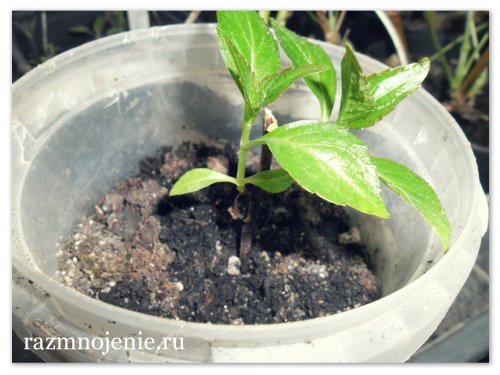

What diseases and pests affect the Vanilla Fries paniculata hydrangea?
The variety has good immunity, so it rarely gets sick. A favorable environment for fungal and viral diseases is created with a high level of air humidity and sudden changes in temperature during the summer months. The fungus is fought with fungicides and preventive measures. Viral diseases, unfortunately, lead to the fact that the plant simply dies.
Most of all, Vanilla Fries is susceptible to powdery mildew. This fungal disease appears with high humidity against a background of low temperatures in the summer. The disease is recognized by the characteristic spots with a powdery gray-white bloom that form on the leaf plate. To get rid of the disease, the bush is treated with vitriol. The composition is used three times at intervals of one and a half weeks (10 days).
Chlorosis often occurs. This ailment is a metabolic disorder in plant organisms. For the treatment of the bush, copper sulfate is used, as well as potassium nitrate. With the exception of the green aphid, other pests rarely infest the hydrangea.
Hydrangea care
Regular care ensures the formation of lush inflorescences of the Vanilla Freise variety. The shrub is looked after by watering and feeding. Pruning the shoots helps to give the bush the desired shape. To protect against diseases and pests, special preparations or folk remedies are used.
Watering
Panicle hydrangea is moisture-loving, so watering is a mandatory step in caring for it. The soil under the bush is moistened every week, it is not allowed to dry out and form on the surface of the crust.
Important! Up to 10 liters of water are added under the panicle hydrangea bush Vanilla Fries.
Only warm, settled water is used for irrigation. In a drought, the shrub is watered more often, up to 2-3 times during the week.
The hydrangea root system is located close to the surface of the earth. Therefore, when watering, make sure that its roots are not exposed. After the introduction of moisture, the soil is loosened and the shrub is spud. Mulching the soil with peat or humus helps to reduce the number of watering.
Top dressing
For the formation of lush inflorescences of hydrangea Vanilla Fraz, nutrients are required. The shrub is fed with organics or mineral complexes. The best results are obtained by alternating different types of feeding.
Panicle hydrangea Vanilla Fries is fed in accordance with the scheme:
- in the spring with swelling of the kidneys;
- when the first buds appear;
- during the period of mass flowering;
- in the fall in preparation for winter.
For the first feeding of the Vanilla Freise variety, an organic mullein-based fertilizer is prepared. Organic matter is mixed with water in a ratio of 1:15. The resulting solution is watered under the root of the bushes.
Summer treatments are performed using mineral complexes. The fertilizer is prepared independently by combining ammonium nitrate, superphosphate and potassium salt. Each substance is taken in an amount of 30 g, after which they are dissolved in water.
Ready-made mineral complexes in the form of dry granules and suspensions have been developed for hydrangea. This fertilizer must be dissolved in water, and then water the bushes under the root.
Autumn dressing of the Vanilla Freise variety is carried out using superphosphate and potassium sulfate. 30 g of each substance is added under each shrub. Fertilizers with nitrogen should be abandoned in autumn so as not to cause increased shoot growth.
Pruning
By trimming the hydrangeas, Vanilla Frazes are given the necessary shape. The bushes are pruned in early spring before sap flow. Be sure to remove dry and broken branches.
Each shoot is shortened to 6-8 buds. In total, 5-10 branches are enough for a bush.
Advice! Pruning shoots at the root helps to rejuvenate the old shrub. Branches with a length of no more than 10-15 cm are left above the surface.
In the summer, the Vanilla Frize hydrangea is not pruned. However, it is necessary to remove dry inflorescences, which leads to the formation of new buds.
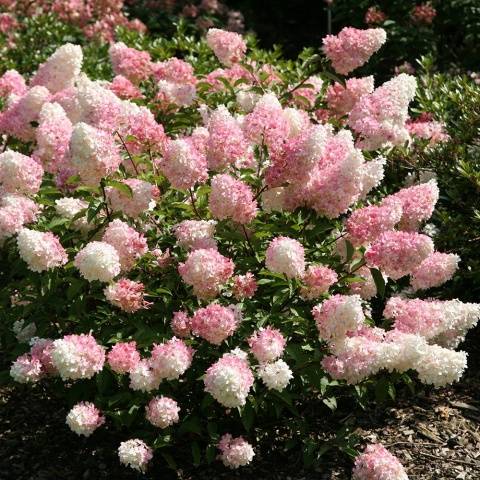

Protection against diseases and pests
Hydrangea Vanilla Fraze can be seriously affected by fungal diseases. In cold rainy weather, plants are susceptible to powdery mildew and various rot. The defeat covers the shoots and leaves of the bush.
To protect hydrangeas from diseases, fungicide-based solutions are prepared. The drugs Fundazol, Fitosporin, Topaz have good medicinal properties. In early spring and late autumn, preventive spraying is carried out.
With a lack of nutrients, the Vanilla Freise variety is prone to chlorosis. The disease is identified by yellow leaves that begin to curl and fall off. To combat the disease, the shrub is fed with a complex fertilizer containing iron.
Attention! Panicle hydrangea attracts pests: snails, aphids, spider mites. All of them feed on plant sap, as a result of which the leaves dry up and fall off, the development of the shrub slows down.
For insects, the shrub is sprayed with solutions using Tanrek or Akarin insecticides. For prevention, folk remedies are suitable: infusions on onion peels or garlic. They are used for processing at any stage of shrub development.
Shelter for the winter
Hydrangea Vanilla Fries endures harsh winters. When grown in the southern regions and the middle lane, the shrub is not covered.
In a cold, snowless winter, mulching the soil with peat or humus helps to protect the hydrangea from freezing. The thickness of the mulch is from 20 to 30 cm.
Young plants must be covered with agromaterial or burlap for the winter. When the snow falls, a snowdrift is thrown over the bushes for additional insulation.
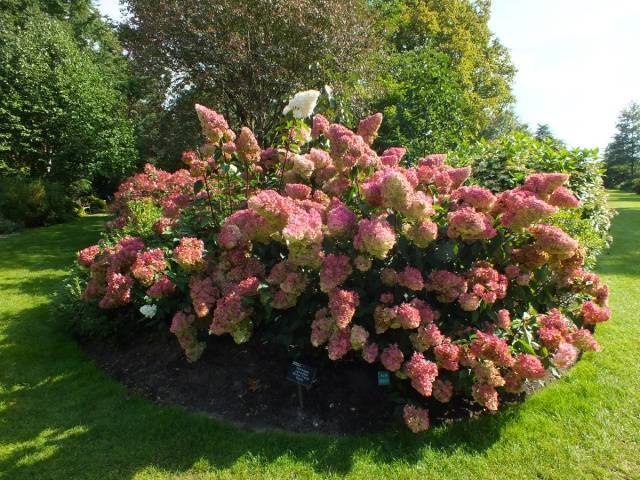

The use of varieties in landscape design
In landscape design, Vanilla Fraz hydrangea is used very often. Experts like the large size of their inflorescences, long flowering, changing color of the petals during flowering, which gives the plant an additional decorative effect.
The plant is tall, so the hydrangea shrub is used as the main background, planting it in the background of flower beds (or in the center). And low flowers are planted in the foreground or at the edges.
Hydrangea in landscape design
These abundantly flowering perennials are also used as a hedge, planting around the perimeter of the site, near the entrance to the country house. These perennials look beautiful near gazebos or open terraces.
The beauty of Vanilla Freise's hydrangea is set off by coniferous shrubs and trees planted nearby.
Panicle hydrangeas are gaining popularity among gardeners around the world. The shrub is notable for its abundant and long flowering. Vanille Fraise is one of the most sought-after varieties. It is grown in warm regions, the middle lane and northern areas.
Photo
More photos of hydrangea paniculate vanilla freesi, see below:
The varieties Phantom, Bobo, Limelight, Kyushu, Pinky Winky and Grandiflora look no less impressive and beautiful. On our website you will find advice from our experts on planting and caring for the beautiful panicle hydrangea.
How to moisturize?
Like other types of hydrangeas, paniculate Vanilla Frazi loves moist soil. To constantly enjoy the beauty of an extraordinary flower, you need to take care of its constant moisture and prevent the soil from drying out. The top layer of the earth should not be dry. Mulching is carried out around the bushes using peat or rotted sawdust. On days when hot weather prevails, at least 30 liters of water should be poured under each bush twice a week. If the summer temperature is not too hot, the hydrangea is watered every 6-7 days.
Why does not it bloom
There are several reasons why Vanilla Fries may not bloom:
- Too much lighting. The optimal time for the sun to shine on the bush is 2-3 hours in the afternoon.
- The soil is overly acidified. The acidity should not exceed 5 pH.
- The soil is alkaline. Hydrangea cannot thrive well in such a land.
- Incorrect pruning.
- Freezing of the bush.
Important! Hydrangeas are very useful whey: bacteria enter the soil and make it acidic and nutritious, which is beneficial for the plant roots.
The unusually beautiful hydrangea has not won awards at exhibitions in Europe for nothing. This culture is very much appreciated in other regions as well. Gardeners dream of decorating the space with this culture. If you have purchased seedlings of this variety, you are very lucky. Use the information in the article and follow the rules for growing perennials. In this case, a charming flowering shrub will grow on your site for a long time, which is famous for the size and uniqueness of the inflorescences.
Description of the variety
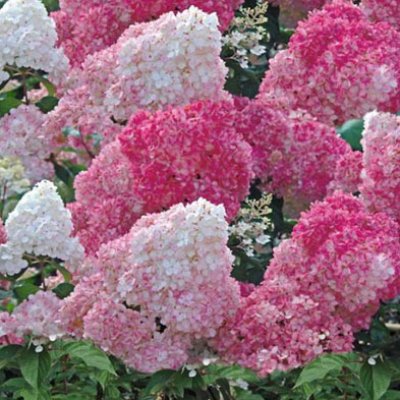

Variety panicle hydrangea vanille fraise was bred by the French gardener-breeder Eric Renaud after 11 years of careful and painstaking breeding work. The variety was fully developed by 2003 and won many prizes at an exhibition in the Netherlands. This species turned out to be incredibly popular due to the beautiful lush pink and white inflorescences and the high frost resistance and unpretentiousness of the plant.
The variety of vanilla fries in appearance is low fast-growing shrub with a diameter of 1.5-2 meters... The crown has an asymmetrical shape. The inflorescences are large and dense, pyramidal in pink-white color and outwardly surprisingly reminiscent of a vanilla-strawberry ice cream cone. The blossoming flowers of the initially white color gradually turn pink. Since the inflorescences bloom and change color gradually, the bush looks very elegant, playing with all shades from snow-white to dark crimson. Leaves are dark green, rough to the touch, oval ovoid. Long flowering from late July to September. The plant has a distinctive feature, it able to withstand very high frosts up to 35-38 degrees.
Young plants can freeze a little in winter, but they easily recover in spring. Therefore, in severe frosts, it is advisable to cover the plant and sprinkle the near-trunk soil with sawdust.
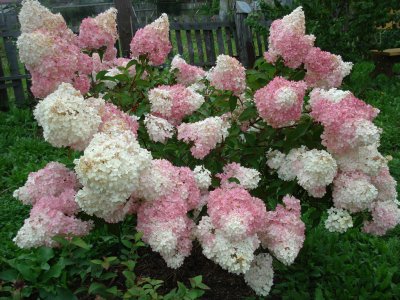

Suitable for almost all regions, except for the hottest and driest, as the plant loves moist soil and partial shade. Also, regions with calcareous soils are not suitable.
This variety is grown for garden and park landscaping and decorative hedges. You can create compositions with other plants or plant them separately.
Landing technique
1. First, you need to prepare special holes measuring 30x30x30 cm, where the seedlings are placed.
Note! Plants should be placed more than 1 meter apart.
2.Fill the finished wells with a special mixture (peat, half a bucket will be enough + compost).
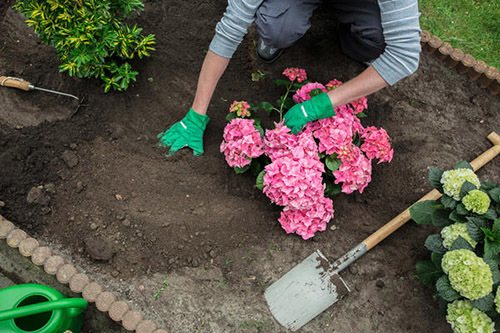

3. Pour water over the resulting hole.
Now you can transfer seedlings into the formed pits.
1. Sprinkle special garden soil on top.
Note! In no case should the root collar be covered with earth.
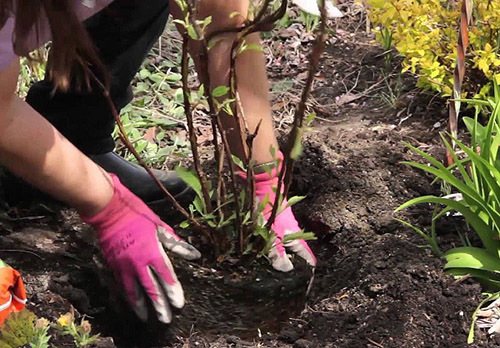

2. Tamp all the soil around the perimeter of the roots
3. Water the resulting pits and loosen the topsoil
4. When planting in hot or sunny weather, provide shelter for the seedlings. This will protect them from possible burns.
Preparing for winter
Pruning is carried out in the spring before the start of active growth, removing frozen and dried stems.
Pruning for this variety has essential: The deeper the pruning, the fuller the new inflorescences will be. In the fall, before wintering, you need to remove all old dried inflorescences.
ATTENTION. Pruning should not be done during sap flow.
The plant is high frost resistance. Older Vanilla Frize hydrangeas only need shelter in very cold climates. In the garden, the plant should be protected from snow from the roof and debris after clearing the paths.
Young plants need a mandatory shelter for the winter, they must be carefully protected with small sawdust or dry grass.
Planting process: from sowing seeds to planting in the ground
You can plant a hydrangea on your site with seeds or with the help of a purchased seedling. It is better to purchase seeds and seedlings in a specialized nursery, where the preservation of the variety will be guaranteed.
Seeds - seedlings and preparation
It takes more than one year to grow a hydrangea from seed to an adult seedling, and practically only breeders are engaged in this when breeding new varieties. Because the seeds do not completely transmit the mother variety genetically and it may turn out that the flowering of the bush will differ from the main mother plant.
But if there is a desire, then we follow the following method of planting seeds:
- we fill a bowl with drainage holes with nutritious soil and moisten with warm water from a spray bottle;
- we spread the seeds over the surface, slightly press them into the ground;
- cover with a transparent bag or glass, put the bowl in a warm and bright place, but not in direct sunlight;
- as soon as shoots appear, the shelter is removed and the seedlings are grown, not forgetting about timely watering.
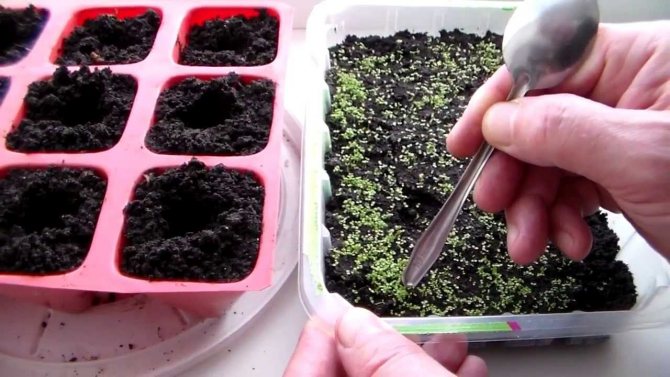

Plant shoots
It is important to ensure that the root system of the seedlings develops and the vegetative green part does not stretch out.
Planting seedlings in the ground
Seedlings with a well-developed root mass are planted in the ground. This requires pits measuring 40 by 40 cm.The holes are dug at a distance of at least 2 m.If they are going to plant a fence, then in this case, the holes are dug at a distance of 80 cm.
5 liters of peat mixed with humus or earth from a compost heap are poured into the finished hole and spilled well with water. Until the water has gone into the hole, a hydrangea seedling is lowered and its roots are spread in different directions. After that, you need to cover the root system with garden soil, and slightly compact it after planting. After planting, spill water again and mulch the plant. Christmas tree litter from under old trees is best suited for mulch, it will protect the soil from drying out, and at the same time acidify the soil to the desired reaction. If there is no coniferous litter, you can fill the planted bushes with sawdust or pine bark.
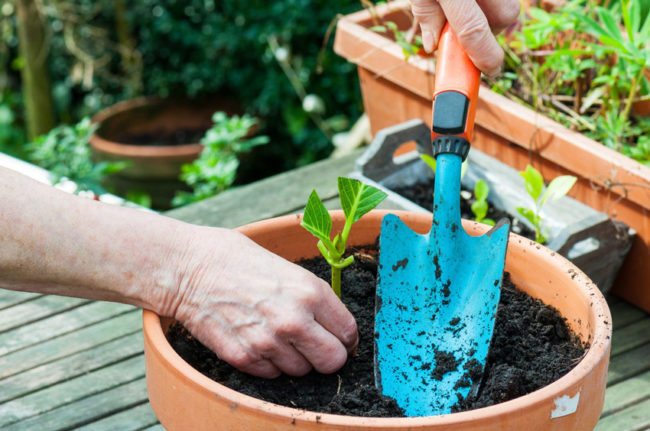

The planted seedlings should be watered, depending on the ambient temperature, 2-3 times a week.
Features of wintering shrubs
It is necessary to prepare the plant for the cold in the fall. First, it is necessary to remove all the leaves from the bush, except for those located at the tops. Cover the root circle with dry earth.
You should know that the plant loves warmth very much, therefore don't be afraid to overheat it and prepare a good and tight cover of material that does not allow air to pass through.Flower buds and shoot tops are most at risk of freezing, so cover them before frost.
In winter, the bush must be carefully sprinkled with snow, but make sure that snow blocks from roofs or trees do not fall on it, otherwise fragile shoots can be severely damaged. In the spring, the bush is initially aired a little, but so that the snow remains on it. The shelter is removed gradually.
Growing features
In order for the Vanilla Frazi hydrangea to please with a beautiful flowering, it is important to follow the rules of its planting and care. It is ideal to plant the plant in spring or autumn. Although if you buy bushes in tubs or pots, when the root system is closed, they take root well in summer.
Lighting
For a plant good lighting is important, otherwise the buds become smaller and lose color saturation. However, in the scorching sun, they also feel bad and burn out. Therefore, for disembarkation, it is better to choose a partial shade that will cover the bush at noon.
What kind of soil does Vanilla Fraze like
The plant loves organic-rich, slightly acidic and moist soils. Lime soil should be avoided. A combination of peat, sand, humus and leafy earth in equal parts is considered ideal.
In addition, the plant loves loose soil. Therefore, before planting, the soil must be loosened by about 5-7 cm and this procedure must be carried out periodically as the plant grows. Remember to mulch the soil.

